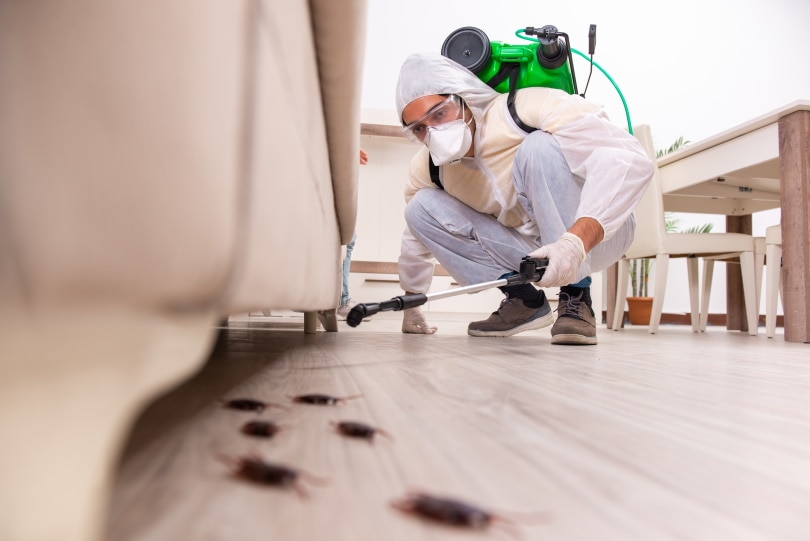How to Bug Bomb a House for Roaches: 10 Easy & Effective Steps!
-
Pete Ortiz
- Last updated:

Cockroaches are one of the most pervasive pests across the United States, invading the nooks and crannies of our homes to spread filth and germs. Prevention is the most efficient method of managing roaches, but given their small size and persistent drive to get into homes, any small oversight can be enough to let an infestation take root.
If you end up with a cockroach problem, you may be interested in trying one of the more aggressive control measures, like bug bombs, also called foggers. We’ll walk you through how to bug bomb a house for roaches to ensure your safety and help eliminate the infestation, hopefully for good.
The 10 Steps to Bomb a House for Roaches
A bug bomb is an aerosol device you activate in a pest-infested room’s center. The canister releases a fog of pesticide particles, which settle on surfaces around the room to kill any cockroaches they touch.
The pesticide in bug bombs is hazardous to humans, and it may put you at risk of developing health issues if you come into contact with any surfaces with remaining pesticide residue. Preparation is crucial to protect individuals and personal items from coming into contact with the pesticide.
1. Measure the Space
Per the EPA’s precautions on using total-release foggers, it is critical to avoid using too many foggers for your space. Use one bug bomb per room at most. Most bug bombs cover a 2,000 cubic-foot area, roughly the size of a 15-foot x16-foot room with 8-foot high ceilings.
Some heavy-duty, whole-home products can cover over 6,000 cubic feet, so you must carefully check the packaging to see how powerful it is. Measure the cubic area (width x length x height) of your room to ensure you use the correct amount.
2. Follow Instructions Carefully
While the general use instructions are consistent with most total-release foggers, you must carefully read the specific directions for your product. Due to the power, application, and pesticide chemicals they use, there may be unique preparation steps, wait times, or cleaning measures to follow.
Without following the product’s instructions, you may risk developing various health problems, from mild skin and eye irritation to respiratory pain and vomiting. Studies have shown that many fogger-related injuries and illnesses were due to consumers not following the manufacturer’s instructions.
Consult a PEST-CONTROL expert
Find a pest-control specialist in your area, and get free, no-commitment estimates for your project.

3. Close Off Ignition Sources
Most foggers contain flammable pesticide particles, presenting a fire risk if you release them in an area with a naked flame. Before you bug bomb for roaches, extinguish any open flames, such as candles and pilot lights for stoves, water heaters, fireplaces, and furnaces.
Foggers can also cause fires within electrical sources, particularly those that cycle on and off, such as your refrigerator. Unplug your appliances, smoke detectors, and electronics before setting off the fogger to prevent it from sparking a flame.
4. Cover Items

Pesticides that settle on surfaces leave a residue that remains long after you bomb your house. The residue can harm humans, so you’ll need to protect many of the materials around your home from coming into contact with the fog. Consider covering the following items to prevent any health issues after the fact:
- Food prep surfaces such as countertops and cutting boards
- Children’s toys
- Kitchen utensils, plates, and glasses
- Sinks
- Pet bowls
- Upholstered furnishings and bedding
Use sheets, plastic coverings, or even newspapers to prevent pesticides from covering your items. Be sure to secure the food in your pantry and your pet’s food to keep it from being contaminated.
5. Close Off Rooms and Turn Off the Air Conditioning
To make the fog as effective as possible, you need to keep it contained in the room and allow it to settle naturally. That means closing off and sealing windows, doors, and other spots that might let pesticides seep through.
Turning off fans and your air conditioner is critical. Doing so will prevent the fog from being blown around or sucked into your central air system, which would waste the pesticide and present a fire hazard.
6. Open Cabinets, Cupboards, and Closets

Fog needs to penetrate any areas that might harbor cockroaches, and those are generally the dark, closed-off corners around the home. To ensure the pesticide reaches as many potential hiding spots as possible, open any cupboards, drawers, cabinets, and closets where you are bombing. Many fogging chemicals stay effective for weeks after applying, which will help you continue controlling roach activity in these hot spots.
7. Inform Your Neighbors
Nobody can enter your home while you are using a fogger for cockroaches. Ensure all rooms are closed and have a sign to alert outsiders of the danger. Contact friends and family members to make them aware as well.
If you share walls with a neighbor, such as in an apartment or townhouse, you should discuss your plan to use bug bombs. They will likely need to vacate their home as well.
8. Place Foggers in the Center of the Room
Depending on the size of your home and the number of rooms you wish to treat, you may need multiple foggers throughout the house. You must place each fogger on a sturdy, flat surface in the center of the room.
If you are using several bombs, plan the order in which you will set off your bombs so that you can safely turn them on as you leave the house. Start on the second floor and work from room to room, moving toward the exit.
9. Vacate the House

There should be no people or pets anywhere in the house when you release a fogger. Even if you are fogging only one room, you must leave the house. Pesticide can still seep into adjoining rooms, and it is extremely hazardous in small doses as the bug bomb goes off.
10. Air Out and Clean Up the Room
After releasing the fogger, you must stay out of the house for several hours. You should open the windows and doors in your home and wait another 1-2 hours to let it air out. Do not let your family or pets re-enter the house when you ventilate it.
When the house is safe to enter, clean up to prevent undue contact with pesticide residue. Wipe down any surfaces that weren’t covered when you fogged. Wash any exposed clothing, linens, and towels as well.
How Long Do You Have to Wait Before Re-Entering the House?
The product packaging will detail the wait times for the fogger application and the ventilation period. It can take anywhere from 2–4 hours or longer for a house to become safe for re-entry. You must follow the manufacturer’s instructions before coming back into the house. If you ventilate the house too early, you will waste pesticide, and you could become ill if you breathe in any lingering particles.
Do Bug Bombs Work Against Roaches?

Bug bombs are effective against various pests, but they are not the most ideal solution for cockroaches. A 2019 study from North Carolina State University found that bug bombs were ineffective against infestations of German cockroaches, a common cockroach species in North America that lives in households year-round. Testing on 20 infested homes, they found that populations did not go down at all after the bombing.
Although they can be effective against flying pests, bed bugs, and many other bugs, consumer fogging products cannot reach all of the cracks and crevices where cockroaches hide. They may kill many cockroaches, but they’re unlikely to affect most of the population. In addition, the NC State study found that German cockroaches may develop resistance to the insecticides commonly used in bug bombs.
What Are the Best Alternatives to Bug Bombs?
Prevention is the best solution for cockroaches. Sealing windows, doors, random cracks, gaps, and holes around the house will help keep cockroaches out. By keeping a clean house and eliminating any food or water sources, you also give cockroaches a few reasons to come into your home.
The 2019 NC study included a test of gel baits as an alternative to bug bombs for roaches. They found that gel baits were effective at removing infestations in the 10 homes they tested, unlike the foggers. You can apply a product such as Combat Max Roach Killing Gel via syringe into hard-to-reach crevices where cockroaches congregate, leaving it to sit and kill any roaches that come into contact with it.
Final Thoughts
Foggers are useful against several pests, but you must exercise care and caution when combating cockroaches. These products are extremely hazardous if misused, so you must carefully follow the manufacturer’s directions to protect your health and home.
Using a bug bomb for roaches should be one part of a multi-faceted treatment plan that starts with putting preventative measures in place. By keeping cockroaches from entering your home and following this guide on how to bug bomb your house, you can effectively keep your family safe and your home completely roach-free.
See Also:
- Are House Centipedes Dangerous? Should You Kill Them?
- 13 Home Remedies for Cockroaches (with Pictures)
Featured Image Credit: Elnur, Shutterstock
Contents



